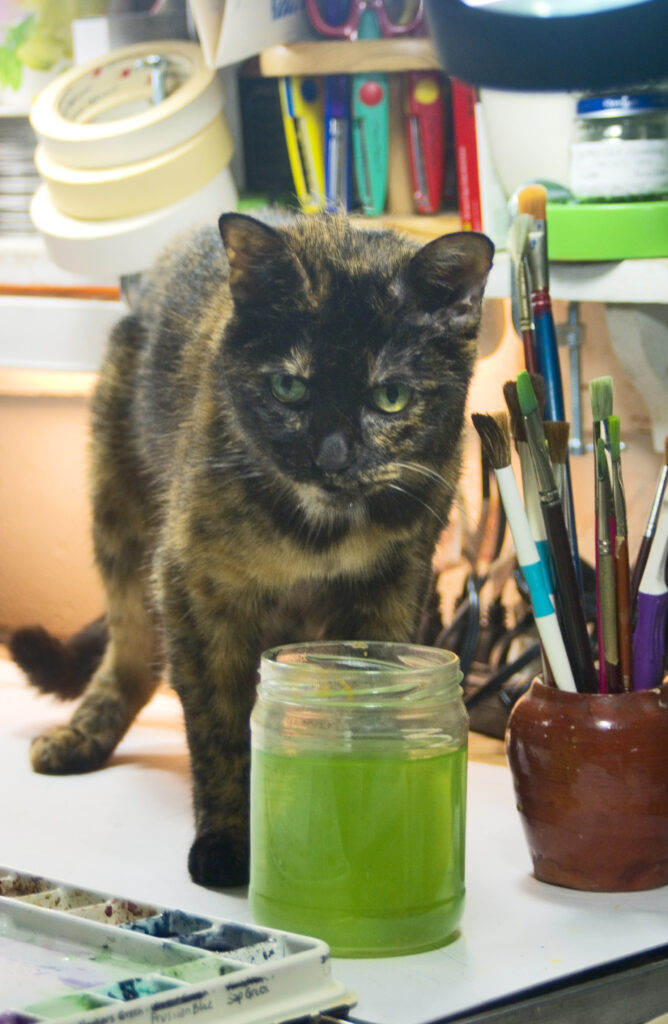“No art project can begin until someone tastes the paint water.”
With any species of pet in the house it’s a good idea to avoid toxins in common household products, but we don’t often consider other products we use in that assessment including items in our home employment or hobbies. Paints, finishes, adhesives, residue from cutting wood, glass, plastic and other materials all have impacts in their original state and also if they become airborne as fumes, dust or aerosols even after we are finished working with them.
What we do around the house
I am a freelance commercial and fine artist, which means I design things and make things for a living. Off my computer I paint with pastels, watercolors and acrylics and also use charcoal, pencils, oil pastels and more. I am also a crafter and use a variety of craft paints and finishes, adhesives, I cut, trim and shred vinyl, labels and papers, I sew and knit and crochet, and plenty more things.
My cats aren’t likely to pick up and eat a pastel, but they do want to drink my paint water and chase yarns and threads as I work. They may, intentionally or not, walk through wet paint, dust from my pastels, brush up against modge podge or clear finish, or I may have it on my hands. And they certainly breathe the air where I’m using these things.
With the growth of entrepreneurs in creative endeavors either adding income with what they make and sell or turning it into a home-based business, I’m sure plenty of artists with cats experience the same thing.
Art and craft materials
While art and craft materials come in various degrees of quality, they are basically made by a small number of manufacturers all using the same ingredients for consistency, There isn’t as big a pool to choose from as, say, house paint or copy paper. In children’s toys and in art and craft materials, dangerous amounts of toxins such as lead and ammonia have been found even though the product passed the testing for its intended use and quality.
ACMI, the Art & Creative Materials Institute, Inc.
I rely on this internationally-recognized certification organization. All materials I use in my house are “AP non-toxic”, certified that kids can eat or drink them and not be hurt by them. Though there is no real testing for toxicity in animals for these products I use the guideline for using supplements and medications intended for humans, following the standard for pediatric use. The standards for testing are stated on their website:
ACMI has a consulting toxicology team at Duke University’s Division of Occupational and Environmental Medicine, who review the complete formulas of products in the certification program. In this evaluation, the toxicology team take into account:
- Each ingredient and its quantity
- Possible adverse interaction with other ingredients
- The product’s size and packaging
- Potential acute and chronic harm to any part of the human body
- Possible allergic reaction
- How a product is commonly used and misused
- U. S. national and state labeling regulations.
All products certified as non-toxic by ACMI are non-toxic for both children and adults because the Toxicologists base their evaluation on the use and misuse (such as ingesting a material) of the product by a small child.
Arts, Crafts & Theater Safety, Inc.
Arts, Crafts & Theater Safety, Inc. (ACT) provided me with a comprehensive data and guide sheet for safe use of art and craft materials. This provides information on reading labels as well as alternate ways in which materials may be used, even unintentionally—like paint dripped and dried on a floor, which becomes a powder dispersed into the air to be inhaled when it’s walked over.
Some common-sense considerations
We’ve all been using art materials since we were babies, right? So we know all about how they should be used and kind of take them for granted—and that can be dangerous with any substance. The ACMI website also offers hints and guidelines about use and storage of art materials that we might be surprised to read.
For instance, we think of tempera paint and clay as wet substances, yet we often purchase them in a dry form to be mixed with water or another substance to activate them. Dusts of any sort can be irritating to asthmatics and people with respiratory issues, as well as the smaller sinuses and lungs of cats and small dogs.
And a habit we should have from other household materials: Fill a baby food jar with paint you’ve mixed and label it with what it is. It’s a good idea to always label substances you’ve moved to another container even if you think you’ll always know what they are, and art materials are no exception.
Never presume your pet has common sense while curiously inspecting something new. Don’t leave your projects and materials unattended, and if necessary, lock your pets out of the area where you are working—yes, they will complain, but they will be safer for it.
In my studio
I let my cats inspect the closed jars of materials, brushes, water and other items. When they’re done I give them boxes to play in and they bathe and nap while I work. I restrict my work to one area so the boundaries are clear.
I always ensure proper ventilation and also use scrap paper and cardboard on surfaces to catch drips and spills. I can simply remove the scrap and add it to the paper recycling bin when I’m done with one activity and move on to the next. That way I’m sure my cats aren’t even walking through dried residue.
So be creative—safely!
References in this article
Art & Creative Materials Institute, Inc. (ACMI)
Handprint
ACTS Labels: Reading Between the Lies (PDF)



